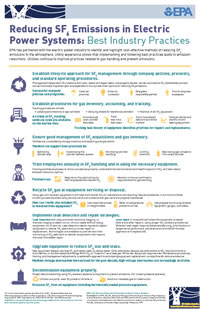Best Practices to Reduce SF6 Emissions

EPA has partnered with the electric power industry to identify and highlight cost-effective methods of reducing SF6 emissions to the atmosphere. Utility experience shows that implementing and following best practices leads to emission reductions.
The Partnership has identified the following as best practices for reducing emissions of SF6:
- Establish a lifecycle approach for SF6 management
- Establish procedures for gas inventory, accounting, and tracking
- Ensure good management of SF6 acquisitions and gas inventory
- Train employees annually
- Recycle SF6 gas at equipment servicing or disposal
- Implement leak detection and repair strategies
- Upgrade equipment
- Decommission equipment properly
Establish a lifecycle approach for SF6 management through company policies, protocols, and standard operating procedures. This approach helps track SF6 inventory and costs, detect and repair leaks, and properly handle, recover, and recycle SF6. Established policies can be continually improved upon and expanded to incorporate other options for reducing SF6 emissions. Successful company policies and programs:
- Cover all practices
- Allow for innovation
- Designate responsible parties
- Train and empower employees
Establish procedures for gas inventory, accounting, and tracking. Tracking procedures include labeling and inventory or gas cylinders, using log sheets for warehouse cylinders, and inventorying all SF6 equipment. Tracking procedures include labeling and inventory of gas cylinders, using log sheets for warehouse cylinders, and inventory of all SF6 equipment. Tracking leak history of equipment identifies priorities for repairs and replacements. Tracking procedures include:
- Labeling and inventory of gas cylinders
- Using log sheets for warehouse cylinders
- Inventory of all SF6 equipment
Ensure good management of SF6 acquisitions and gas inventory. Utilities are consolidating storage inventory and selecting a single vendor. Vendors can support best practices by:
- Optimizing cylinder size
- Customizing the cylinder delivery system
- Minimizing cylinder handling
- Limiting inventory
- Maximizing gas utilization from every cylinder
Train employees annually in SF6 handling and in using the necessary equipment. Training enables employees to follow procedures properly, understand the environmental and health impacts of SF6, and learn about emission reduction options. Partners can:
- Require on-the-job training for field employees who handle SF6
- Maintain in-house certification requirements for gas handling
Recycle SF6 gas at equipment servicing or disposal. Using gas cart recovery equipment to off-load and transfer SF6 for maintenance and recycling reduces emissions. It is critical to follow correct procedures when using service carts and to ensure that gas carts are properly maintained. Operators can verify that residual SF6 is removed from equipment by:
- Using mass flow scales or weight scales
- Referring to temperature/pressure curves
- Using properly functioning recovery equipment, gauges, and scales
Implement leak detection and repair strategies. Leak detection with soap and water solutions, bagging, or thermal imaging to detect minor, chronic leaks without taking equipment out of service. Leak detection teams regularly inspect equipment to identify SF6 leaks and prioritize repair or replacement. Technologies are available to provide real-time monitoring of SF6 leaks and to identify components that require the most immediate repair. Leak repair is most efficient when the equipment is tested before and after repairs, using proper SF6 recovery procedures. Effective leak repair requires advanced planning, prioritization to target worst performers, and evaluation of whether the best approach is to replace GIE.
Upgrade equipment to reduce SF6 use and leaks. New equipment designs use less SF6 and tighter seals to reduce leaks. Other designs use alternatives to SF6, like vacuum-based technology with CO2, or “Clean Air” as a base gas. While new equipment requires new maintenance procedures, training, and management adjustments, a systematic approach to anticipating equipment replacement can significantly reduce emissions. Medium-voltage alternatives have existed for the past decade; high-voltage alternatives are increasingly available.
Decommission equipment properly. Proper decommissioning using SF6 recovery systems is important to prevent emissions. For closed-pressure systems, utilities can purify used SF6 onsite or off-site or send non-reusable gas for destruction. Evacuate SF6 from all equipment including hermetically sealed pressure equipment.
For more information on SF6 emissions, please see Overview of SF6 Emissions Sources.
